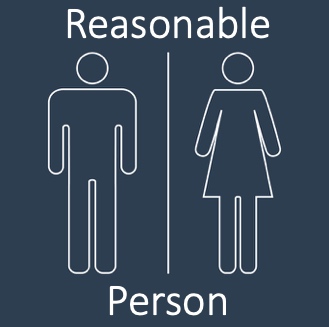By Dr. Ken Broda Bahm:

The idea of something being a “Legal Fiction” is that it is treated as true for the purposes of the law, but it is not literally true. “A corporation is a person” is perhaps one of the best known of these legal fictions, and one that generates passionate disagreements. As the familiar meme goes, “I’ll believe a corporation is a person when Texas executes one.” But even without popular acceptance, the legal force of it remains. Of course, people outside of the law have another name for a legal fiction: “a lie.” Or maybe in today’s age, it is “fake law!”
One legal fiction is the familiar “reasonable person standard,” or the idea that negligence or some other fact can be assessed by determining what a reasonable person in the same or similar circumstances would understand, do, or refrain from doing. It matters in many contexts, one of those being the definition of sexual harassment in the workplace. There is a two-prong subjective/objective test for determining it. The subjective test is whether it is unwelcome and sufficiently severe to the complainant. And the objective test is whether, from a reasonable person’s perspective, the behavior would also meet that standard. But is the objective prong really objective? According to a new study from researchers at the University of Nebraska, Lincoln (Wiener & Vardsveen, 2018), no it isn’t. The idea that there is any uniform nationwide standard that we can call the “reasonable person” on such matters is also a legal fiction. In this post, I’ll take a look at the study and its implications.
The Research
The research, from Professor Richard Wiener and Trace Vardsveen at the university’s Legal Decision Making Lab, surveyed 361 research participants. In an online study, the participants read a brief vignette of a job interview that varied in several ways.
The female applicant experienced extreme objectifying behavior from the male interviewer (long-duration staring at her chest and comments about her appearance), less extreme behavior (shorter duration), or no such behavior.
The female applicant either complained to another about the harassment or did not.
The female applicant either reportedly enjoyed or rejected being objectified, or treated in a sexualized manner.
Comparing the resulting 12 conditions, the researchers asked the research participants to essentially act as that ‘objective’ standard and report their own views on whether a reasonable person would consider the behavior to be harassing. They found that evaluations of harassment varied not just based on the scenario, but based on the research participant’s gender and based on their own tendency to either enjoy or to reject the idea of being sexualized (as measured by the ESS or “Enjoyment of Sexualization Scale”). So the response is, predictably, that the perception of harassment depends on who you ask, and the so-called objective prong of sexual harassment is subject to significant individual differences. They note, “these findings challenge the existence of a unified standard, which not only breaks down by gender, but further splinters depending upon whether participants do or do not enjoy sexualization.”
The Implications
The research carries a few reminders for addressing the idea of the “reasonable person” in the context of harassment litigation.
Know Your Audience
In the absence of a general and truly objective standard, the notion of the “reasonable person” is in the eye of the beholder. So it helps to know the beholder. In this study, for example, the research participants’ own reported enjoyment of sexualization played a key role in determining how those participants would see the reactions of a reasonable person. Indeed, that mattered more than the presence of complaints and the complainant’s own attitudes about sexual attention. So the subjects of whether sexual attention should be considered flattering or hostile, whether it is ‘harmless flirting’ or harassment, are definitely subjects to explore with as much frankness as you can in voir dire.
Especially the Women
One particularly interesting finding from the study relates to gender differences. The distinction between ‘mild’ and ‘severe’ harassment was significant for men, but not for women. For men, as you’d expect, the severe examples were more likely to be considered harassment, but not for the women. For women, the authors theorized, it is a threshold issue. They found any objectification to be harassing, whether ‘mild’ or ‘severe.’ This finding reinforces the tendency observed in some courts to embrace a “reasonable woman standard” rather than a “reasonable person standard.” But even this adaptation is not the complete answer, because there are still important individual differences.
And Conduct Research
The researchers argue for admissibility of social science evidence on attitudes regarding harassment. Drawing a parallel with litigation on obscenity, which after moving beyond the Potter Stewart standard of “I know it when I see it,” similarly allowed for research on community standards, the authors argue that research such as theirs would help jurors in assessing the objective prong of a harassment case. “Data from a national sample,” they write, “may help decision makers in hostile work environment cases to rely on a more uniform understanding of what is hostile and abusive.” Failing that, it is still important for counsel to research the expectations, even if that is just for your own preparation and strategy. Conducting a mock trial or a community attitude survey can be quite helpful in grounding and improving your argument, knowing that the “reasonable person” perception of harassment isn’t a uniform or neutral standard but is instead one that varies depending on the venue, the times, and the specifics of your case scenario.
Other Posts on Workplace Harassment:
- Address the Silence of a Delayed Harassment Claim
- Take a Broader View of Workplace Harassment
- React to the #MeToo and #HimToo Scripts
Wiener, R. L., & Vardsveen, T. C. (2018). The objective prong in sexual harassment: What is the standard?. Law and human behavior.42:6, 545-557.